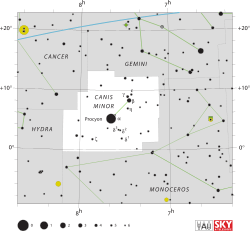Delta2 Canis Minoris
- For other star systems with this Bayer designation, see δ Canis Minoris.

| |
| Observation data Epoch J2000 Equinox J2000 | |
|---|---|
| Constellation | Canis Minor |
| Right ascension | 07h 33m 11.66576s[1] |
| Declination | +03° 17′ 25.3551″[1] |
| Apparent magnitude (V) | 5.589[2] |
| Characteristics | |
| Spectral type | F2 V[3] |
| U−B color index | +0.10[4] |
| B−V color index | +0.31[4] |
| Astrometry | |
| Radial velocity (Rv) | +0.8[5] km/s |
| Proper motion (μ) | RA: –16.16[1] mas/yr Dec.: 41.81[1] mas/yr |
| Parallax (π) | 23.95 ± 0.30[1] mas |
| Distance | 136 ± 2 ly (41.8 ± 0.5 pc) |
| Details | |
| Radius | 1.0[6] R☉ |
| Luminosity | 1.0[7] L☉ |
| Temperature | 7053 ± 159[8] K |
| Rotational velocity (v sin i) | 117.6[9] km/s |
| Other designations | |
Delta2 Canis Minoris (δ2 CMi, δ2 Canis Minoris) is a star in the constellation Canis Minor. It is one of three stars that share the Bayer designation Delta Canis Minoris in Johann Bayer's 1603 Uranometria atlas of bright stars. The Flamsteed designation for this star is 8 Canis Minoris, indicating it is the eighth star in the constellation Canis Minoris listed in John Flamsteed's 1712 star catalogue.
As of 2008, no companion has been discovered orbiting δ2 Canis Minoris; it appears to be a solitary star.[7][10] The apparent magnitude of 5.589 means this star is visible to the naked eye, although it is faint and requires a dark sky to view.[11] Based upon parallax measurements, this star is about 136 light years distant from the Earth.[1]
This star is rotating rapidly; the projected rotational velocity is 117.6 km/s,[9] which means that the equator of this star is rotating at this velocity or greater. By comparison, the Sun is a slow rotator with an equatorial azimuthal velocity of 2 km/s.[12] δ2 Canis Minoris has a stellar classification of F2 V,[3] indicating that this is an F-type main-sequence star that is generating energy at its core through thermonuclear fusion of hydrogen. The effective temperature of the photosphere is about 7053 K,[8] giving it the yellow-white hue that is characteristic of F-type stars.[13] The radius of this star can be estimated indirectly based upon the measured brightness and color information, which suggests the star is about the same size as the Sun.[6]
References
- 1 2 3 4 5 6 van Leeuwen, Floor (November 2007), "Validation of the new Hipparcos reduction", Astronomy and Astrophysics, 474 (2): 653–664, arXiv:0708.1752v1
 , Bibcode:2007A&A...474..653V, doi:10.1051/0004-6361:20078357 Note: see VizieR catalogue I/311.
, Bibcode:2007A&A...474..653V, doi:10.1051/0004-6361:20078357 Note: see VizieR catalogue I/311. - 1 2 "8 CMi -- Star", SIMBAD, Centre de Données astronomiques de Strasbourg, retrieved 2011-12-09
- 1 2 Cowley, A.; et al. (April 1969), "A study of the bright A stars. I. A catalogue of spectral classifications", Astronomical Journal, 74: 375–406, Bibcode:1969AJ.....74..375C, doi:10.1086/110819
- 1 2 Johnson, H. L.; et al. (1966), "UBVRIJKL photometry of the bright stars", Communications of the Lunar and Planetary Laboratory, 4 (99), Bibcode:1966CoLPL...4...99J
- ↑ Wilson, Ralph Elmer (1953). General Catalogue of Stellar Radial Velocities. Washington: Carnegie Institution of Washington. Bibcode:1953GCRV..C......0W.
- 1 2 Pasinetti Fracassini, L. E.; et al. (February 2001), "Catalogue of Apparent Diameters and Absolute Radii of Stars (CADARS) - Third edition - Comments and statistics", Astronomy and Astrophysics, 367 (2): 521–524, arXiv:astro-ph/0012289
 , Bibcode:2001A&A...367..521P, doi:10.1051/0004-6361:20000451 Note: using the method of Perrin and Karoji (1987).
, Bibcode:2001A&A...367..521P, doi:10.1051/0004-6361:20000451 Note: using the method of Perrin and Karoji (1987). - 1 2 van Belle, G. T.; et al. (May 2008), "The Palomar Testbed Interferometer Calibrator Catalog", The Astrophysical Journal Supplement Series, 176 (1): 276–292, arXiv:0711.4194
 , Bibcode:2008ApJS..176..276V, doi:10.1086/526548
, Bibcode:2008ApJS..176..276V, doi:10.1086/526548 - 1 2 Paunzen, E.; Schnell, A.; Maitzen, H. M. (October 2006), "An empirical temperature calibration for the Δ a photometric system. II. The A-type and mid F-type stars", Astronomy and Astrophysics, 458 (1): 293–296, arXiv:astro-ph/0607567
 , Bibcode:2006A&A...458..293P, doi:10.1051/0004-6361:20064889
, Bibcode:2006A&A...458..293P, doi:10.1051/0004-6361:20064889 - 1 2 Schröder, C.; Reiners, A.; Schmitt, J. H. M. M. (January 2009), "Ca II HK emission in rapidly rotating stars. Evidence for an onset of the solar-type dynamo", Astronomy and Astrophysics, 493 (3): 1099–1107, Bibcode:2009A&A...493.1099S, doi:10.1051/0004-6361:200810377
- ↑ Eggleton, P. P.; Tokovinin, A. A. (September 2008), "A catalogue of multiplicity among bright stellar systems", Monthly Notices of the Royal Astronomical Society, 389 (2): 869–879, arXiv:0806.2878
 , Bibcode:2008MNRAS.389..869E, doi:10.1111/j.1365-2966.2008.13596.x
, Bibcode:2008MNRAS.389..869E, doi:10.1111/j.1365-2966.2008.13596.x - ↑ Bortle, John E. (February 2001), The Bortle Dark-Sky Scale, Sky Publishing Company, retrieved 2011-12-09
- ↑ Stix, Michael (2004), The sun: an introduction, Astronomy and astrophysics library (2nd ed.), Springer, p. 423, ISBN 3-540-20741-4
- ↑ "The Colour of Stars", Australia Telescope, Outreach and Education, Commonwealth Scientific and Industrial Research Organisation, December 21, 2004, retrieved 2012-01-16